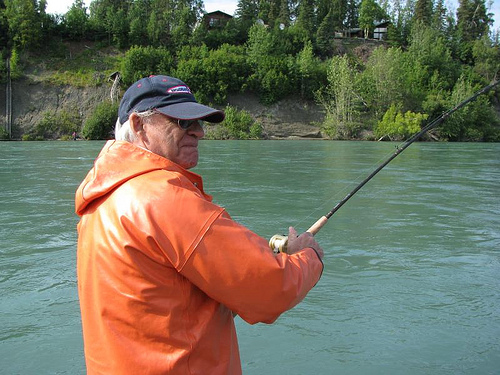 George Ure and Gaye Levy, Contributors
George Ure and Gaye Levy, Contributors
Activist Post
Not coincidentally, with the approach of Easter (April 8th) and Passover (April 6-14) we are once again drawn to the mysterious linkage between this time of the year and fishing.
George holds that the reason lowland lakes fishing in many states doesn’t open until the following week has everything to do with marketing of various religious services. Gaye, though, wonders whether the Ichthys, the so-called “fish symbol” might have more to do with it.
Regardless, since this is the time of year, just before and a few weeks after the Spring Solstice, when topics turn to fishing, we thought to ask ourselves several reasonable questions about the pursuit of fishing as a survival skill.
One is whether fishing is a hobby or a delusion. True, under exceptional circumstances, a lucky fisherperson may be able to separate a fish from its native aquatic haunts, but the odds are definitely in the fish’s favor.
Or, more properly, they used to be.
With the advent of portable electronics, we’ve seen a literal invasion of the formerly simple business of fish-catching with all kinds of electronic gizmos.
George, having lived on a sailboat and cruising for a good chunk of his live aboard days, is quick to make a distinction between waterborne collision-avoidance systems and more common fish finders.
‘At the beginning of my sailing period,’ begins George, ‘I was happy with a simple paddle-wheel type knot meter to measure how fast the boat was going. But then, as microprocessors came to pass, I learned how the low-powered sonars could be used to spot good anchorages, and from there, into finding where halibut and other dinner-time treats hung out.’
To hear him tell it, and fishermen (even the reformed sort) will go on endlessly about such things, there has been a real decline in the traditional “fishing sense” that serious salt water anglers developed. “We used to look for a flock of seagulls, particularly down in South Puget Sound,” he explained. “Under them was usually a school of herring, and not too far away, at least at certain times of the year, black-mouth, silver, and king salmon would be found. Today, with fish-finders, those basic fisherman/guide skills, reading the water, watching the direction of gulls, things like that are being replaced by electronics.”
Depending on the size (and depth) of fish, a look-ahead sonar is really marvelous. Although West Coast trolling and seiners are down from all-time highs in the 1960s and 1970s, look ahead sonar is becoming a favorite accessory for lots of long-range cruisers, whether on trawlers (think Grand Banks) or offshore capable sailboats (dream Hans Christian 43’). One thing holding up on boats under 30-35 feet is the cost of the new class of look-ahead sonars. An EchoPilot 3D is an amazing tool, but at just a bit under $9,000 it’s not the kind of thing you’d stick on your bass boat.
For that kind of application, Garmin makes their 300c sunlight readable ($180) while HumminBird’s 586c gets generally high marks for a tad under $350.
Salt Water Vs. Fresh Water Survival
We all have bug-out bags, and many include “fishing survival kits” like the Best Glide Adventure kit for $24 or SurvivalStuff’s $4.99 kit. There’s even a $7 compact survival fishing kit of British Navy issue.
 So we come to our first “fork in the river” on survival fishing: does the river empty into the ocean, or into a fresh water lake of some kind? And, faced with the equipment problem, what’s the “right” answer?
So we come to our first “fork in the river” on survival fishing: does the river empty into the ocean, or into a fresh water lake of some kind? And, faced with the equipment problem, what’s the “right” answer?
An inspection of any emergency survival fishing kit will quickly indicate what size fish are intended to be caught. In the case of the British Navy, the hooks would likely be larger since the British Navy doesn’t do much in the way of patrolling small lakes and rivers, such as are found in most of America. On the other hand, if you have a small sailboat, or you find yourself in a saltwater setting, the British kit might be ideal.
On the other hand, the Best Glide kit would offer more fishing options; more choices in hook size and lures, which at least in theory would make fishing more productive.
So how do we choose?
Travel or Resettlement?
We continue trying to corral a “right answer” by looking at the type of fishing being contemplated. If you are looking for a fishing plan while traveling to some kind of destination, then the small, portable fishing kits make sense. If you’re thinking along these lines – sorry for the bad pun – remember to toss out all the preconceptions about “rules” and “sportsmanship.”
On the other hand, if the time ever were to come when you were reduced to overland travel, depending on passing rivers and lakes for protein-to-go, we would first and foremost relearn how to set up a trotline, no question about it. (A trotline is a heavy fishing line with baited hooks attached at intervals by means of branch lines called snoods.)
It may be comforting to people who are not serious fisherpersons to “think” they have a fishing kit, but we’re more pragmatic about things (strategic is our first name, right?). So, to our way of thinking, the way to approach the whole “survival fishing” problem is to reduce it to a simple to remember formula:
Your odds of catching a fish are directly proportional to: NF (number of available fish) times NL (number of lures in their vicinity).
Naturally, a couple of packets of hooks of different sizes is convenient, but given even something relatively disgusting as potential bait, if you hang enough lures out there, your odds of getting fed by your bounty will go up dramatically.
Trotlines are often used on the Mississippi for catching catfish, which might not sound good in a setting where you can’t deep–fry the hush puppies to go with it, or find a bottle of two of Bud, but those are the kind of sacrifices that come with real survival planning.
The first peoples of America knew a lot about survival and part of their skill set involved food preservation and the need to be mobile. Fishing sounds great – in a Huckleberry Finn, Life on the Mississippi way. But the hard reality of survival is shown with a little math. We live in a country of 312-million people on 3.112 million square miles. That pencils out to 100-people for every square mile of land.
Let’s be real here. Back out 160,820 square miles of lakes and rivers, and then throw out most of Arizona, most of Nevada, and good-sized pieces of Washington, Oregon, Utah and mountainous regions of every state along the Rockies and you’re likely looking at 130 persons per square miles.
In a genuine survival situation, anything in the way of stored food and tools to get fresh protein out of the water is going to be very much in demand. We’ll cover a “Comparison of Bug Out Countries” in an upcoming report, but our point right here is that sustaining 125 humans per square mile is not achievable with a small “survival fishing kit” on any kind of long-term basis. The two issues which will have to be dealt with will be the two P’s: production and preservation.
Modern culture doesn’t do a very good job of capturing first people’s skills, although reading a book like “Messages from Frank’s Landing: A Story of Salmon, Treaties, and the Indian Way” (if you can find a copy) reveal a very different mindset about survival; one where nomadism is “baked in the cake” as it taken as a given by many tribes. Huckleberries and wild strawberries and smoked salmon sound good, if not somewhat romantic. But have you ever split a sapling, bunkered the fire, and sat for hours while the fish was smoked and dried?
It’s in such settings, as George relates it, having spent some time on the Nisqually at the landing while covering the 1974 judge George Boldt Decision on Indian fishing rights, that the matter of survival fishing comes into clearer focus. T’ain’t as easy as you think.
Beyond the Trotline
Since a real “survival situation” would involve a breakdown of usual order, if your plan for survival involves being on a lake or river, there are some other items you might want to consider. One is real fishing nets, since one sure way to get whatever is in a river it to get nets completely across it, and such nets can be had in 9 by 50 foot hunks or in 9 by 100 foot lengths.
Something to have handy when you start pulling up the nets is a good slingshot line because when you start pulling things out of the water, birds tend to show up – and even if you don’t nail a bird which looks tasty, there’s a good change it will be suitable for bait use.
Living on bullheads isn’t particularly fun – and it takes a lot of small fish to make up a meal, so consider a few crayfish traps on the freshwater side if you’re really thinking about fish as a source of survival protein.
On the saltwater side, survival is a little friendlier, provided you’re willing to do some walking. Since all three of America’s coasts are possibilities, depending on where you live, why not consider a good shovel?
We both agree that a clam shovel, which is also available as a trenching shovel some places, is just the thing for digging up water lines and other troublesome chores in normal times. But when times get bad, this is the ideal shovel for getting at clams, or for scraping large mussels off piers and pilings, with concrete piling-growth mussels being preferred since they aren’t growing up around creosoted wood which might have some tainting effect.
Not that in a survival situation that would matter, at least in the short term.
With such a shovel, you could also dislodge decent-sized rocks and under these you’ll often find crabs. (Although don’t forget that on the coast, a good crab pot may also be in order). And if you have the sense to wade out a bit into the water, many bays have fascinating varieties of seaweed available. If you go that route, a 20-pound sack of rice, a cooking pot, and a copy of Crystal June Maderia’s “The New Seaweed Cookbook” will make the feast a lot tastier.
We might also nudge you in the direction of seafood harvesting practice now, since in a bug-out situation, you wouldn’t have the modern world’s elaborate medical system to fall back on, should your first adventures be less than spectacularly successful.
On Sportsmanship, Ritual, and Rules
 Both G’s have significant boating experience: Gaye on a large powerboat and George on a large sailboat. Neither of us views fishing as anything other than stepping stone in long-term survival and prepping plans. Even Pacific Coast Indians realized that the summer king salmon, the fall and winter silvers and blackmouth were not a whole solution.
Both G’s have significant boating experience: Gaye on a large powerboat and George on a large sailboat. Neither of us views fishing as anything other than stepping stone in long-term survival and prepping plans. Even Pacific Coast Indians realized that the summer king salmon, the fall and winter silvers and blackmouth were not a whole solution.
Likewise, in modern times, should we get to a breaking point in society as we know it, or should a devastating regional event such as an earthquake or massive solar flares take out the grid, we would need a lot more than a simple $5 fishing kit to keep us going.
On the other hand, for traveling light (which means quickly) over country, an assortment of fishing gear, particularly trotline and netting, makes sense, since it could be teamed up with land side options such as snares to possibly come up with a suitable meal.
Even so, absent a set of oars, that Bayliner ski boat with even the best available depth sounder would be of little use when the gasoline onboard is gone. At that point, only a solar panel would light up the fish-finder, but you might want that panel for charging up night lights, or recharging the shortwave radio so you could keep up on what news reports might be around that could guide you in your personal response to whatever situation has overcome humankind.
We looked into fishing with an open mind and discovered the depths of our delusion on the topic was, curiously, very much tied to the maintenance of a seemingly ever-increasing bureaucracy.
We discovered, for instance, that there are two kinds of fisherman in Nevada – those part of a state “Sportsman” program and those who just want a Resource Enhancement Stamp. As we read this from the Nevada Department of Wildlife site:
Laws regarding child support mandate that any person who is required by federal law to have a social security number must provide the number to obtain a business, occupational or recreational license and certificate numbers and validation decals for boats. Federal Law – Public Law 104 – 193; Nevada Statute – NRS 488.078, 502.063, 503.5833, 504.390
Yeesh. We were taken back to a time when a Social Security card was promised never to be used for identification, and, along in that same period, when we were both very young, there were no fishing licenses at all, at least for saltwater sportsmen, and the freshwater license was only a couple of dollars.
So a broader question surfaces as we cogitate on which has more long-term survival potential: fish as fishing or fish as bureaucracies?
While we wait for that to be figured out, the Environmental Protection Agency has done a very thorough series of National Aquatic Resource Surveys which you can wander through here. It should give you some ideas of what’s available, but at the same time, remember some of those dandy looking waters in Montana, Wyoming and along the northern tier, don’t work in winter time.
Our bottom line? We lean toward nets, shovels, and trot lines.
Introducing Strategic-Living: a practical and useful online magazine providing inspiration and guidance as we make our way through the maze of changes that are coming our way. In collaboration with my friend and colleague, George Ure, Strategic-Living will offer a synthesis of Urban Survival and Backdoor Survival with much more detailed tips, tools and strategies for creating a vibrant and sustainable lifestyle wherever your path may take you. Think of Urban Survival and Backdoor Survival as your roadmap and Strategic-Living as your detailed guidebook. Here you will find articles and photos, diagrams and how-to’s, and a healthy dose get-out-there and do it with kick-in-the-ass inspiration.
linkwithin_text=’Related Articles:’



Be the first to comment on "Fishing as a Survival Skill"